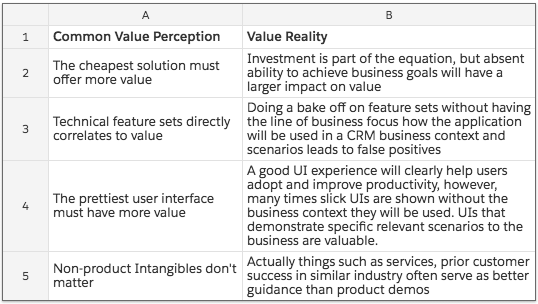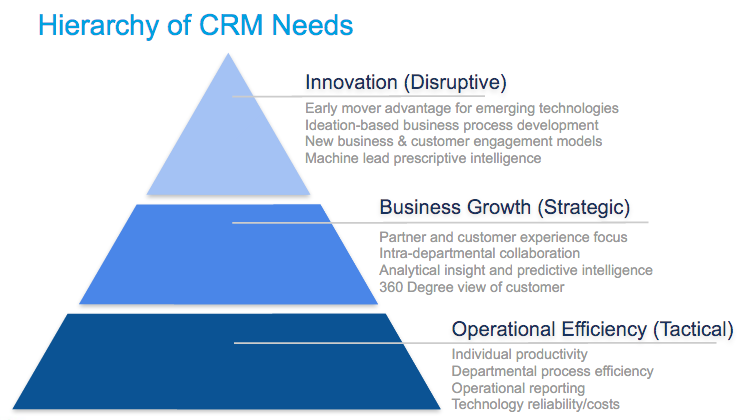
Get your FREE 30-day trial.
Please complete all fields.
Over the past two decades, companies have been turning to CRM to increase business value and improve relationships with customers. But the definition of value differs for each company and impacts how they select and implement a CRM. Their value expectations will drive how they select and implement a CRM application.
I have yet to see a definition of value that has the word “cheap” in it. Value, in the CRM sense, is about trying to achieve a desirable business goal for investments made. When CRM application leaders put too much emphasis on low price as a desired outcome, it often leads to re-implementation or low adoption of the selected application. This reminds me of a variation of the famous quote from Benjamin Franklin:
“The bitterness of poor quality (value) remains long after the sweetness of low price is forgotten” – Benjamin Franklin
Ben Franklin had no visibility into CRM, but, as with many thinkers of his era, he thought well beyond his time on core principles. Just because a company pays a low price, that does not mean they will get value for their purchase. CRM application leaders often get lost evaluating specific features or looking at screens thinking it is an easy shortcut to compare CRM applications or vendors (see Table 1). Often value gets associated with which vendor has more features, or a better user experience without knowing the context of the business value that can be achieved. Don't get me wrong, technical features have a role in the value calculation but it falls short of ensuring a company will achieve the business value they desire. Another way companies will justify value is to get as many features as possible at the cheapest price. It is not that simple. Over my 20 year career, I saw companies with similar problems take two different paths. One company would go with the cheapest vendor and the second company would go with the vendor that was more expensive. More often than not the second would always find more value in their decision. That said choosing a higher price solution does not guarantee business value. It is looking beyond feature/price equation value perception that is the real key to success.

When I look at the more than 10,000 customers I have helped over the years, it was very clear to me why some got value and others did not. The ones who did benefit had a value system that drove their decision and business priorities. For new customers just starting out on their CRM journey saying we have nothing and all we need is “something” is not describing their values. Usually, when I heard we need “something” that is code for give me the cheapest solution so I can check the box on having a CRM system for my executive management team. A better route to success is to determine your CRM needs and focus before purchasing a solution. If you have no value need, it is probably not a good idea to embark on anything, because why dump money into any initiative if you have no expectation of value in return. Using a simple Hierarchy of CRM Needs (see Figure 1) will help CRM application leaders determine what CRM capabilities are important to their company.

There are three basic segments of needs companies will fall into. Some companies will start at Innovation, while others will focus on Operational Efficiency and mature their needs as they gain more experience, while others may find no need to move up segments. As a company moves up the hierarchy the needs must be met to be successful. So the first step in understanding value is to first determine what your company's CRM values are. If you don't fall into anyone of these segments then you will never be able to answer the question on whether you got value, even if the software was free. Let's take a deeper look at the characteristics of each segment.
Operational Efficiency (Tactical)
Companies fall into this segment often have already implemented a system that has run “out of gas,” or it is implementing a CRM system for the first time. Most of the focus is on eliminating administration burden to increase productivity, improve data quality and visibility to make more informed decisions, or cut cost out of the business. The CRM application must be reliable, offer seamless upgrades, and provide a data model and reporting environment that is easily adaptable to the business. Failure to offer these will run counter to business value improving financial position. The CRM application must be assessable in the environment that the user works in. For example, a sales person has strong mobile capabilities where a customer service rep has good integration with their call center infrastructure.
Business Growth (Strategic)
Companies who value business growth have much broader expectations for the CRM implementation. The ultimate outcome is to accelerate revenue growth through improving the customer experiences by implementing a much deeper set of functionality capabilities that may cut across departmental boundaries. From a technology perspective, a data model and platform that supports a 360-degree view of the customer is a must-have to provide the operational insight and predictive intelligence to make more informed business decisions. Pending on the business model, CRM applications are extended directly to touch customers and partners, placing an even higher emphasis on reliability of the CRM application platform.
Innovation (Disruptive)
Companies who fall into this category are fundamentally trying to disrupt the business model in an industry segment. Uber or Lyft are the most often used examples. Companies in this segment are fundamentally transforming how customers are engaged, and/or how a customer purchases a product. These companies are innovative in their business model, therefore are also innovative in their CRM technology adoption. They choose CRM application providers that have a proven track record for innovation and going forward with a particular focus on Artificial Intelligence to scale the business.
Understanding what your organization's CRM values before you select a vendor, spend money, and implement CRM software greatly reduces being tossed into the scrap heap of failed implementations. By doing the pre-work on getting the organization to agree on CRM values it will enable a journey that leads to increasing success.